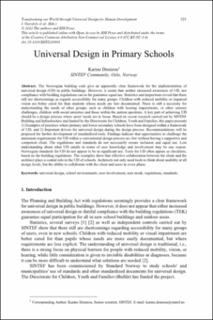| dc.contributor.author | Denizou, Karine | |
| dc.date.accessioned | 2022-09-14T05:18:54Z | |
| dc.date.available | 2022-09-14T05:18:54Z | |
| dc.date.created | 2022-09-13T07:49:01Z | |
| dc.date.issued | 2022 | |
| dc.identifier.citation | Studies in Health Technology and Informatics. 2022, 297 525-532. | en_US |
| dc.identifier.isbn | 978-1-64368-304-1 | |
| dc.identifier.isbn | 978-1-64368-305-8 | |
| dc.identifier.issn | 1879-8365 | |
| dc.identifier.issn | 0926-9630 | |
| dc.identifier.uri | https://hdl.handle.net/11250/3017638 | |
| dc.description.abstract | The Norwegian building code give an apparently clear framework for the implementation of universal design (UD) in public buildings. However, it seems that neither increased awareness of UD, nor compliance with building regulations can so far guarantee equal use. Statistics and inspections reveal that there still are shortcomings as regards accessibility for many groups. Children with reduced mobility or impaired vision are better cared for than students whose needs are less documented. There is still a necessity for understanding the needs of other groups, such as children with hearing impairments, or other sensory challenges, children with social anxieties and those within the autism spectrum. A key part of achieving UD should be a design process where users’ needs are in focus. Based on recent research carried out by SINTEF Building and Infrastructure and funded by the Directorate for Children, Youth and Families, this paper presents 1) Examples of practices where primary and lower secondary schools have been designed within a framework of UD, and 2) Important drivers for universal design during the design process. Recommendations will be proposed for further development of standardized tools. Findings indicate that opportunities to challenge the minimum requirements for UD within a conventional design process are few without having a supportive and competent client. The regulations and standards do not necessarily ensure inclusion and equal use. Low understanding about what UD entails in terms of user knowledge and involvement may be one reason. Norwegian standards for UD do not appear to be in significant use. Tools for UD often appear as checklists, based on the building regulations. The examples show that effective collaboration between the client and the architect plays a central role in the UD of schools. Architects not only need tools to think about usability at all design levels, but the ability to collaborate with the client and users in every phase. | en_US |
| dc.language.iso | eng | en_US |
| dc.publisher | IOS Press | en_US |
| dc.relation.ispartof | Transforming our World through Universal Design for Human Development | |
| dc.relation.ispartof | Proceedings of the Sixth International Conference
on Universal Design (UD2022) | |
| dc.rights | CC BY-NC 4.0 | * |
| dc.rights.uri | http://creativecommons.org/licenses/by-nc/4.0/deed.no | * |
| dc.subject | Universal design | en_US |
| dc.subject | School environments | en_US |
| dc.subject | User involvement | en_US |
| dc.subject | User needs | en_US |
| dc.subject | Regulations | en_US |
| dc.subject | Standards | en_US |
| dc.title | Universal Design in Primary Schools | en_US |
| dc.title.alternative | Universal Design in Primary Schools | en_US |
| dc.type | Journal article | en_US |
| dc.type | Peer reviewed | en_US |
| dc.description.version | publishedVersion | en_US |
| dc.rights.holder | © 2022 The authors and IOS Press | en_US |
| dc.source.pagenumber | 525-532 | en_US |
| dc.source.volume | 297 | en_US |
| dc.source.journal | Studies in Health Technology and Informatics | en_US |
| dc.identifier.doi | 10.3233/SHTI220883 | |
| dc.identifier.cristin | 2051017 | |
| cristin.ispublished | true | |
| cristin.fulltext | original | |
| cristin.qualitycode | 1 | |

